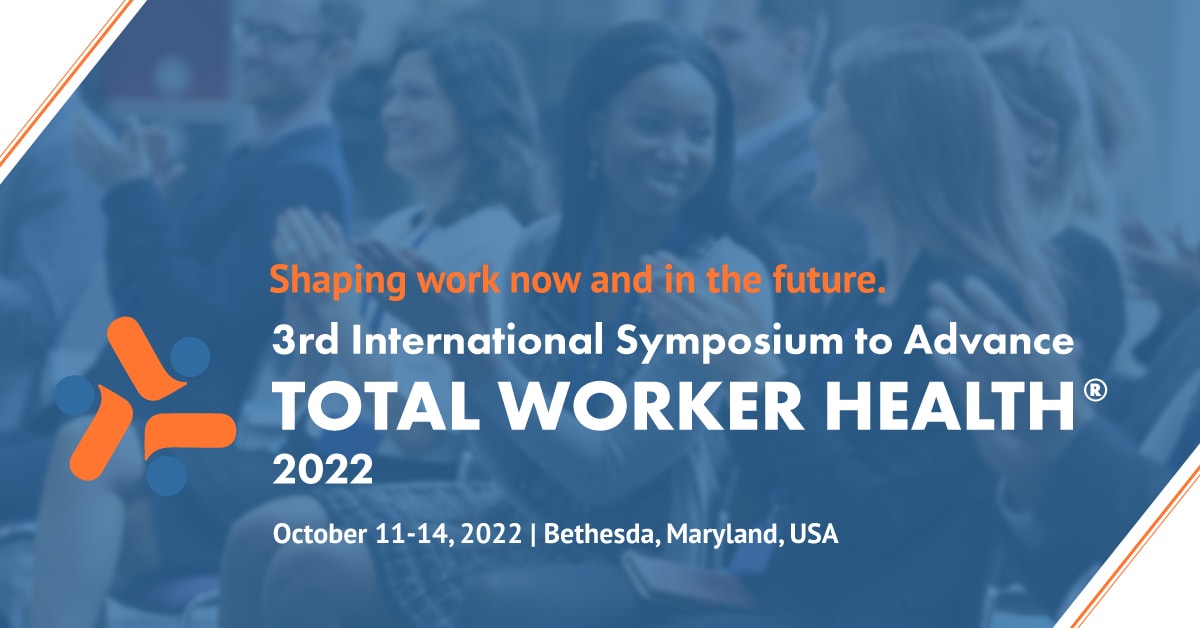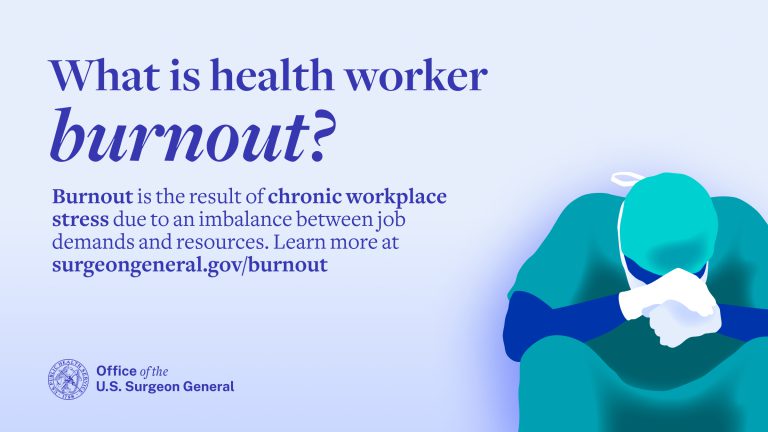Total Worker Health in Action: June 2022
Volume 11, Number 2, June 2022
Director’s Buzz
L. CASEY CHOSEWOOD, MD, MPH
I am thrilled to announce that registration is now open for the 3rd International Symposium to Advance Total Worker Health®. Protecting workers’ safety, health, and well-being is as crucial than ever. Since the last symposium in 2018, the evidence base for the Total Worker Health (TWH) approach has grown and flourished, along with the number of TWH affiliates and Centers of Excellence for TWH, who will share the latest research and practical applications.

Image courtesy of the Center for Health, Work & Environment
Whether you’re just getting started or already an expert on TWH strategies, there’s something for you! The symposium will feature presentations and workshops for those establishing an integrated, holistic approach, and will take a deeper dive into TWH applications on important issues like the future of work, substance use, and mental health.
Mental health is a crucial part of worker well-being and was a focus of our previous newsletter. For many organizations, it is their highest priority. We hear you, and we are directing many of our team’s resources toward this challenge. I am excited to share an update on CDC and NIOSH efforts to protect health worker mental health. In this issue’s News From NIOSH, learn about a new advisory from Dr. Vivek Murthy, U.S. Surgeon General, highlighting the urgent need to address health worker burnout. I encourage you to read and share these resources as we all work to address this important issue. Soon NIOSH will roll out additional elements of a national, multimedia campaign to support health workers in vital ways.
As always, we love hearing from you! For the latest TWH news, research, and events, follow us on Twitter at @NIOSH_TWH, join our NIOSH Total Worker Health LinkedIn Group, or send us an email at twh@cdc.gov.
Total Worker Health Exclusive
Sneak Peek at the 3rd International Symposium to Advance Total Worker Health®
What? The 3rd International Symposium to Advance TWH focuses on advancing TWH research, practice, policies, and programs. We invite you to join us for compelling keynote addresses, expert presentations, interactive panels, quick “bright spots” on best practices, and informal, hands-on workshops emphasizing the latest strategies aligned with a TWH approach. This year’s symposium represents the largest, most compelling collection on the science and practice of TWH ever offered in one event.
When? October 11–14. The conference is two and a half days with general and concurrent sessions. Virtual offerings will launch then and be available on demand after the conference.
L. Casey Chosewood, MD, MPH, Executive Editor
Emily Kirby, Managing Editor
Sarah Mitchell, Associate Editor
Cheryl Hamilton, Copy Editor
Margaret Bertsch, NIOSH Web Developer
Please send your comments and suggestions to us at twh@cdc.gov.
To receive the NIOSH TWH email newsletter, enter your email address:
Where? In person and online! The in-person conference will be at the National Institutes of Health Natcher Conference Center in Bethesda, Maryland. For the first time ever, the conference will also offer a rich agenda of select live and recorded presentations online for virtual attendees. Options to have access to both in-person and virtual content are available.
Who? Join an audience of safety and health professionals, employers, researchers, policymakers, organized labor representatives, and members of the academic community. Occupational health physicians, medical directors, mid-levels, nurses, and support staff will also find highly applicable content. We welcome public health, mental health, employee assistance program, health promotion, and workplace well-being professionals as well.
Why? This one-of-a-kind symposium examines opportunities to make workplaces safer and to improve the health and well-being of workforce across the world. This is the only NIOSH-sponsored event focused solely on advancing TWH research, practice, policies, and programs. The symposium builds upon successful past meetings, including the 2004 NIOSH Steps to a Healthier U.S. Workforce Conference, the 2007 NIOSH WorkLife National Symposium, the 2014 International Symposium to Advance TWH, and the 2018 International Symposium to Advance TWH.

Registration is now open
- Registration is now open for in-person presenters. Open registration begins July 11. Learn more about registration options.
- The early bird registration rate ends August 31, so don’t miss your chance for a discount.
- The planning committee will offer a limited number of scholarships covering conference registration fees for select individuals. Learn more about how to apply.
What to expect
- Continuing education is available! Attendees will qualify for the following continuing education credits: CME, CNE, CEU, CHES®, CPE, CPH, CIH, CSP, and SHRM.
- This is the first time that virtual attendance is available. Virtual presentations will be prerecorded and delivered through the event platform. In addition, we anticipate that select content from the in-person event will be available to live stream. On-demand access to all presentations, including general sessions, scientific presentations, and virtual posters, will be available through the end of January 2023.
- Stay tuned for the agenda for a full list of presentations, workshops, and posters.
- The symposium will feature information on the launch of the Total Worker Health® Society. The Center for Health, Work & Environment (CHWE) is spearheading the launch of the society (keep scrolling to learn more from CHWE in their update).
Join the symposium mailing list to get updates straight to your inbox. We can’t wait to see you there!
Promising Practice
The NIOSH Total Worker Health program developed this article in collaboration with Jonathan Rosen, MS, CIH, FAIHA, National Clearinghouse for Worker Safety & Health Training

Photo by Thinkstock
National Institute of Environmental Health Sciences Worker Training Program (NIEHS WTP) Training Curricula and Resources to Combat the Opioid and Substance Use Crises
CDC reported more than 103,000 overdose deaths in the 12-month period ending December 2021 [CDC 2022]. Work-related injury, pain, and stress are all pathways to opioid use, misuse, and opioid use disorder [Applebaum et al. 2019; Shaw et al. 2020]. There is an urgent need to train workers and employers on how to prevent and respond to the opioid and substance use crises. Training is an essential step in getting employers, labor, and communities to start addressing these outcomes [Burke et al. 2006; Ruttenberg and Rice 2019].
The NIEHS WTP, with support from the National Institutes of Health (NIH) Office of Disease Prevention, developed three training programs that are available to labor, employers, and community organizations to raise awareness about occupational risk factors for opioid and other substance use, misuse, and addiction. These six-hour interactive courses are designed for the classroom and adjusted for virtual delivery during the pandemic. Materials include a PowerPoint deck and numerous large and small group activities. Most are also available in Spanish. Organizations may integrate or adapt these materials into their training programs.
- The Opioids and the Workplace: Prevention and Response training uses the public health model of primary, secondary, and tertiary prevention. It focuses on injury and stress prevention (primary), early access to screening and appropriate treatment for impacted workers (secondary), and recovery-supportive workplace programs that improve access for treatment and recovery (tertiary). The course concludes with action planning so participants can outline next steps. Instructor training, which uses a companion instructor manual, was delivered to several training organizations.
- Opioids and the Workplace: Leadership Training Program aims to facilitate action planning by organizational leaders from management and labor, helping to identify gaps and opportunities for improvement in their workplace drug programs. The actionable objectives include (1) Identifying strategies to improve prevention of workplace hazards that may result in opioid use, (2) Summarizing ideas for improving organizational systems to help injured workers avoid use of opioids, (3) Reviewing reforms for organizational policies and systems related to treatment/recovery and return-to-work, and (4) Developing a list for follow-up actions including training and other improvements.
- Prevention of Occupational Exposure to Fentanyl and Other Opioids is awareness training for (1) emergency responders who may be exposed to opioids when reviving a person who has overdosed or (2) law enforcement responding to a criminal complaint.
Preventing and addressing opioid misuse and substance use disorders are priority areas for the NIOSH TWH program. NIOSH examines these issues through the lens of work, risk reduction, and worker well-being. The NIEHS WTP training programs are consistent with the four-part framework NIOSH developed to address the opioid crisis in the workplace: identifying workplace conditions, determining risk factors, protecting workers and responders, and developing methods for detection and decontamination [NIOSH 2018]. TWH outreach, education, and training are also included in the priority areas. The NIEHS opioid/substance use training programs provide a key, core curricula that anyone can use and adapt.
NIEHS produced a document titled Initiatives to Prevent Opioid Misuse and Promote Recovery Friendly Workplace Programs summarizing the initiatives, training programs, toolkits, and resources developed by employers, labor unions, community-based organizations, and government agencies. Learn more in a recent NIOSH Science Blog and through these resources:
- Download the NIEHS WTP training resources from the NIEHS National Clearinghouse for Worker Safety and Health Training website.
- Contact the NIEHS grant recipients for hazardous materials training, including training on opioids and the workplace.
- Find additional training resources and learn more about the NIEHS Worker Training Program.
References
Applebaum KM, Asfaw A, O’Leary PK, Busey A, Tripodis Y, Boden LI [2019]. Suicide and drug-related mortality following occupational injury. Am J Ind Med 62(9):733–741, https://onlinelibrary.wiley.com/doi/10.1002/ajim.23021.
Burke MJ, Sarpy SA, Smith-Crowe K, Chan-Serafin S, Salvador RO, Islam G [2006]. Relative effectiveness of worker safety and health training methods. Am J Public Health 96(2):315–324, https://doi.org/10.2105%2FAJPH.2004.059840.
CDC [2022]. Provisional drug overdose death counts. By Ahmad FB, Rossen LM, Sutton P. Hyattsville, MD: Health and Human Services, Centers of Disease Control and Prevention, National Center for Health Statistics (NCHS), https://www.cdc.gov/nchs/nvss/vsrr/drug-overdose-data.htm.
NIOSH [2018]. Opioids in the workplace: framework. Cincinnati, OH: U.S. Department of Health and Human Services, Centers for Disease Control and Prevention, National Institute for Occupational Safety and Health, https://www.cdc.gov/niosh/topics/opioids/framework.html.
Ruttenberg R, Rice C [2019]. Assessing the impact of health and safety training: increased behavioral change and organizational performance. Am J Ind Med 62(11):986–995, https://doi.org/10.1002/ajim.23026.
Shaw WS, Roelofs C, Punnett L [2020]. Work environment factors and prevention of opioid-related deaths Am J Public Health 110:1235–1241, https://doi.org/10.2105/AJPH.2020.305716.
Funding support from NIEHS WTP Contract number 75N96021D00008 task order number 75N96021F0001 with contributions from NIH Office of Disease Prevention.

Photo courtesy of CDC
Spotlight on Opioids in the Workplace
Editor’s note: If you or someone you know needs assistance (in English or Spanish) with mental health concerns or substance use disorders, prevention, and recovery, please contact SAMHSA’s National Helpline at 1-800-662-HELP (4357) or visit SAMHSA’s Find Help webpage.
Each year, the National Safety Council recognizes National Safety Month in June. This annual observance reminds us to help keep each other safe from the workplace to any place. This year’s observance recognizes musculoskeletal disorders, workplace impairment, injury prevention, and slips, trips, and falls. Many factors can cause workplace impairment, including fatigue, long hours of work or tough working conditions, work stress, and substance use. The NIOSH Workplace Supported Recovery webpage describes how employers can use evidence-based policies and programs to cultivate a recovery-supportive workplace. A recent NIOSH Science Blog also explores issues of impairment related to cannabis at work.
Learn more about opioids in the workplace and, in case you missed it, scroll up to learn about resources to prevent and address opioid misuse in the Promising Practice.
News from NIOSH

Addressing Health Worker Burnout: New Surgeon General Advisory
The Surgeon General’s advisory highlights the urgent need to address health worker burnout. The advisory lays out recommendations for healthcare organizations, policymakers, health insurers, and others to address the systemic causes of health worker burnout and improve well-being. Learn more about what CDC and NIOSH are doing in this NIOSH Science Blog about the Health Worker Mental Health Initiative.
How Work Can Impact Mental Health and What Leaders Can Do
This timely webinar recording features discussions on work, mental health, and leadership. Speakers also talk about the connections between our mental health and working conditions, along with ways leaders can prevent and address mental health challenges. Free continuing education is available for this activity. Visit the TWH Webinar Series to find more recordings, and learn about how to get continuing education credits.
NIOSH Worker Well-Being Questionnaire (WellBQ) Updates
New NIOSH WellBQ resources are now available! Learn more about the questionnaire in a video “Assessing Worker Well-Being” from the Healthier Workforce Center of the Midwest, a NIOSH Center of Excellence for TWH. The questionnaire is also available in Spanish. Contact twh@cdc.gov to learn more about administering the WellBQ in your own workplace.
What is Safety Climate? Definition and Practical Applications
Did you miss the latest TWH webinar? Learn about what safety climate is, its impact on worker health, and practical applications in this recorded webinar. Free continuing education is available.
News From the NIOSH Centers of Excellence for TWH
- The California Labor Laboratory is developing a strong public outreach program while research projects gear up. The Center is hosting monthly webinars, the fourth Wednesday 12–1 p.m., addressing topics like employment in the warehouse industry, the impact of the pandemic, and low wage labor. They also held their first annual conference on precarity in employment and its consequences May 17–18. Find details and listen to the recorded talks on the Center’s website.
- The Carolina Center for Total Worker Health®and Well-being co-sponsored the annual Southeast Regional Research Symposium and Southeastern States Occupational Network Annual conference in March 2022 in Chapel Hill, North Carolina. In collaboration with the North Carolina Occupational Safety and Health Education and Research Center (ERC) and regional ERCs, this was the first year that TWH was introduced as a priority focal topic at the Southeast’s leading occupational safety and health research conference. Dr. Sara Tamers from the NIOSH TWH Program participated as the Dillon-Carnahan keynote speaker.
- The Center for Health, Work & Environment (CHWE) is working to increase awareness and adoption of evidence-based diabetes and cardiovascular disease prevention and management programs, by launching an employer market assessment, employee risk test, and an employer decision map. In addition, CHWE introduced new online courses, including Mental Health Training for Managers and Workers and a TWH Leadership 101 Skillsoft course for University of Colorado employees. CHWE members are also spearheading the TWH Society, which will serve as a transdisciplinary community of researchers, educators, professionals, practitioners, students, and others who share a common interest in advancing worker health, safety, and well-being. To receive updates about joining the Society, contact Lili Tenney.
- The Center for the Promotion of Health in the New England Workplace (CPH-NEW) recently unveiled the TWH Trends: Expert Webinar Series. In the first of the series, Dr. Marnie Dobson shared Addressing Worker Mental Health: The Healthy Work Campaign. CPH-NEW continues to provide education and training opportunities, including the latest e-learning course, TWH for Occupational Safety and Health Professionals.
- The Center for Work, Health, & Well-being is pleased to welcome several visiting scholars this summer. Adam Chati, PhD, will work with Center Associate Director Jack Dennerlein from May through July, funded by a Fulbright Scholarship. Adam is a Professor of Human Management and Organizational Behavior and Faculty of Law, Economics and Social Sciences at Hassan II University of Casablanca in Morocco. Siw Tone Innstrand, PhD, will work with several investigators in July and August, funded by a Fulbright Scholarship. She is a professor in occupational health psychology in the Department of Psychology and Director of the Center for Health Promotion Researchat the Norwegian University of Science and Technology.
- This year, the Healthier Workforce Center of the Midwest (HWC), the Nebraska Safety Council, and the Nebraska Chamber of Commerce offered a new award at the Nebraska Safety Council Annual Conference and Trade Show. The Worker 360 Award Program is for companies that encourage and promote the prevention of occupational injuries and illness in their workplaces and achieve superior results in the success of their safety and wellness programs. HWC also released a new podcast Pocketbook Pains: How Health Care Financing Impacts Patients. The episode features an interview with the St. Louis Area Business Health Coalition and Dr. Jay Moore, Chief Clinical Officer with Paytient, to discuss current and future trends in healthcare financing, the impact of benefit design, and solutions to aid patients in affording care.
- The Johns Hopkins Psychosocial, Organizational, and Environmental Total Worker Health®Center in Mental Health (POE Center) held a panel for National Farmworkers Awareness Week in March. The POE Center and Johns Hopkins Education and Research Center will hold an inaugural Mental Health in the Workplace Fall Summit in hybrid format (on-site and online) October 6–7.
- The Oregon Healthy Workforce Center’s (OHWC) Co-Director, Dr. Leslie Hammer, received a Distinguished Faculty Award, recognizing outstanding applied research and extensive contributions to the field of worker well-being. Catch up with recent podcast episodes, including Designing Flexible Work to Create a Just Economy for Black and Latinx Women and Inclusion and Worker Well-being in the Trades (Parts 1 and 2). Learn more about OHWC’s activities from the last year of its 2016–2021 cycle in their newest annual report.
- The University of Illinois at Chicago (UIC) Center for Healthy Workwill recognize National Preparedness Month in September with a social media campaign titled “Emergency Preparedness for All Workers.” The campaign will focus on protecting vulnerable workers during emergencies by highlighting lessons learned from the pandemic, providing tips for communities and employers, and identifying the effects of climate change on the future of work. Contact healthywork@uic.edu by August 15 for access to the social media kit and instructions.
- The Utah Center for Promotion of Work Equity Research recently hosted the Spring Community Conference. The conference featured a keynote talk from Dr. Emily Q. Ahonen, a panel of Community Health Workers, presentations, and discussions from other community-based organizations in Utah, as well as a mini-workshop focused on how members of the community can interact with researchers to promote TWH. Conference debriefings will be distributed through social media (Twitter, Instagram, LinkedIn, and Facebook) and newsletter The conference also marked the opening of a Community Mini-Grant Program.
These are just a few of the updates from the NIOSH Centers of Excellence for TWH. To learn more about each of the Centers and their response efforts, visit their websites.
News from Partners
A Closer Look at the Great Resignation From the American Industrial Hygiene Association
Over 4.5 million American workers left their jobs in November 2021, the highest number since the Bureau of Labor Statistics began keeping these figures in December 2000. A recent article in the Synergist “Worker Well-being in the Great Resignation: A Story of Risks, Ills, and Cultures” analyzes the impact of this phenomena and explores the role of the TWH approach. The article describes the TWH framework and shares the experience of a TWH working group formed to address concerns about the great resignation and declining productivity.
Call for Journal Submissions
The Workplace Health & Safety Journal is seeking submissions for its Current Topics section, the most popular type of manuscript among the journal’s readers. Papers should be a one-page (700 word) article on current occupational health and safety issues. Those covering a broad range of current topics are welcome. If you are interested or have questions, contact Dr. Marie-Anne S. Rosemberg or submit directly through the manuscript submission portal.
New Report on Workplace Mental Health
Mental Health America released the new Mind the Workplace 2022 Report: An Employer’s Responsibility to Employee Mental Health. The report aims to describe how employers can meaningfully support employee mental health in 2022. Data in the report come from the Work Health Survey, which measured the perceptions of 11,300 employees across 17 industries in the United States during October 30, 2020–August 31, 2021.
St. Louis Area Business Health Coalition (BHC) 2022 Community Forum
The BHC Community Forum 2022, Advanced Primary Care: A Prescription for Better Health, was held in June with business and healthcare leaders. The forum explored data on the current state of primary care and characteristics of advanced primary care, including employer and provider priorities. The forum also highlighted primary care innovations that are improving access, care quality, and patient outcomes across the country.
Updates From the Ohio Bureau of Workers’ Compensation
The NIOSH Center for Workers’ Compensation has a long-standing partnership with the Ohio Bureau of Workers’ Compensation (BWC). Ohio BWC launched a new grant program for the research and development of new personal protective equipment technologies. Ohio BWC continues to offer a grant program for Ohio-based universities, recently announcing this year’s awardees.
Featured Affiliates: Get to Know the NIOSH TWH Affiliates
This feature was created to introduce our readers to current NIOSH TWH Affiliates. See how the NIOSH TWH Affiliates responded when we asked about their work.
Affiliate: Labor Occupational Health Program
Affiliate: Eugene Water and Electric Board
Learn more about the TWH Affiliate program.
New Publications and Resources
Conferences, Webinars, and Training
June
3 – OHWC hosted the symposium “From the Great Resignation to the Great Reconfiguration: Connecting Research and Practice.” The day-long online event was designed for occupational safety and health, human resource and other workplace professionals, workplace advocates, students, and occupational health researchers. Recordings are now available.
27 – Registration opens for the 3rd International Symposium to Advance TWH. Along with NIOSH, CHWE is coordinating the symposium, which will be hosted virtually and in-person at the National Institutes of Health Natcher Conference Center in Bethesda, Maryland, October 11–14.
July
19 – Save the date for OHWC’s Occupational Health Psychology Summer Institute! This day-long, online event is titled “TWH Approaches in Industry And Academia: Key Elements and Implementation.” Read about OHWC’s Summer Institutes, past and present.
August
18 – Health Links will host their annual event to celebrate Colorado employers committed to workplace health, safety, and well-being. They will honor award winners and finalists for their achievements in the workplace, and provide attendees the opportunity to network and gain inspiration from other employers.
31 – CHWE will host a webinar “The Highs and Lows: How Substance Misuse Impacts Your Workplace” at 11 a.m. (MT). Join Health Links™, along with national and local experts, to learn more about how to understand and address substance misuse in your workplace.
September
8-9 – The National Association of Worksite Health Centers 9th Annual Forum is in Nashville, Tennessee. The event will have formal and roundtable sessions. Sessions will focus on worksite health center topics like planning and design, operations, staffing and management, and legal and regulatory aspects.
October
6-7 – The POE Center and Johns Hopkins Education and Research Center will hold an inaugural Mental Health in the Workplace Fall Summit.
11-14 – The 3rd International Symposium to Advance TWH will be hosted virtually and in-person at the National Institutes of Health Natcher Conference Center in Bethesda, Maryland.
Find more events on the NIOSH Conferences, Meetings, Webinars, and Events webpage.
Total Worker Health® is a registered trademark of the U.S. Department of Health and Human Services (HHS). Mention of any company or product does not constitute endorsement by the National Institute for Occupational Safety and Health (NIOSH), Centers for Disease Control and Prevention (CDC). In addition, citations to websites external to NIOSH do not constitute NIOSH endorsement of the sponsoring organizations or their programs or products. Furthermore, NIOSH is not responsible for the content of these websites. All web addresses referenced in this document were accessible as of the publication date.

